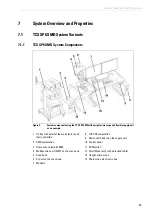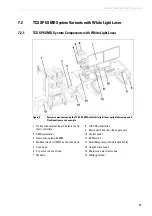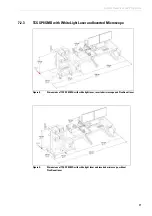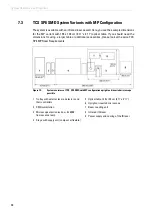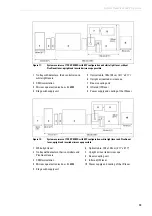
45
Ambient Conditions
8
Ambient Conditions
Here you can find a summary of the information regarding the size and design of the room
and the general requirements regarding ambient conditions. Be absolutely sure to comply
with the ambient conditions.
8.1
General Requirements Regarding Ambient Conditions
• You may use the system only in indoor areas that are dust-free. The room must be free
of dust, oil and chemical vapors.
• Avoid direct sunlight and vibrations, since these can distort measurements and
micrographic scans. We also recommend using a room that can be completely
darkened.
• The room must meet national safety regulations for laser safety areas.
• Never expose the system to rain, fluids, or humidity. Do not set up the system under
water pipes, air-conditioning systems, or other piping. Otherwise, this could cause fire
and electrical shocks to the system and the electrical components.
• The room should be equipped with a telephone connection to contact Leica
Microsystems CMS GmbH for phone support. For RemoteCare, an Internet connection is
also needed.
• The system should be set up in a separate room, in order to be able to provide a constant
temperature and appropriate ambient lighting without having to address needs of other
systems, instruments, and room users.
Temperature range for
operation
18 to 25 °C (64 to 77 °F)
optimum optical behavior
22 °C ± 1 °C (72 °F ± 1.8 °F)
Pollution degree
2 (protect system against dust)
Permitted relative humidity
20 to 60% (non-condensing)
Maximum location elevation
2000 m above sea level
• HyD RLDs are cooled. To ensure optimal performance from the detectors, the humidity
of the surrounding air must not exceed 60% at 25°C. To prevent potential damage due to
condensation, the cooling shuts off automatically if its value is exceeded.
8.2
Vibrations
Vibrations must be reduced to a minimum; for that reason, do not set up the system near any
of the following sources of vibration: shakers, ultracentrifuges, pumps, compressors,
refrigerators, vending machines, elevators.
Frequency range [5 Hz – 30 Hz]
less than 30
μ
m/s root mean square
Frequency range [> 30 Hz]
less than 60
μ
m/s root mean square
Maximum tolerable vibrations:
Summary of Contents for TCS SP8 SMD
Page 1: ...10 Living up to Life User Manual Leica TCS SP8 SMD for FCS FLIM and FLCS ...
Page 4: ...4 Copyright ...
Page 14: ...14 Contents ...
Page 18: ...18 Intended Use ...
Page 20: ...20 Liability and Warranty ...
Page 28: ...28 General Safety Notes ...
Page 32: ...32 Additional Notes on Handling the System ...
Page 44: ...44 System Overview and Properties ...
Page 60: ...60 SMD Components Figure 31 DSN 102 Dual SPAD Power Supply ...
Page 80: ...80 Safety Features ...
Page 102: ...102 Switching On the System ...
Page 116: ...116 LAS AF ...
Page 214: ...214 Changing the Specimen ...
Page 216: ...216 Changing the Objective ...
Page 238: ...238 Switching Off the System ...
Page 242: ...242 Repairs and Service Work ...
Page 244: ...244 Maintenance ...
Page 246: ...246 Disassembly and Transport ...
Page 248: ...248 Disposal ...
Page 254: ...254 Contact ...
Page 256: ...256 Recommended Literature ...
Page 266: ...266 Appendix Figure 225 Declaration of conformity ...
Page 268: ...268 Appendix ...
Page 269: ......



